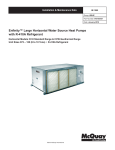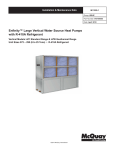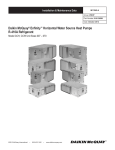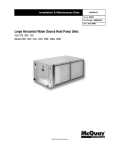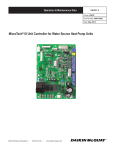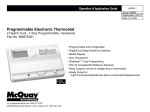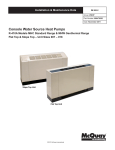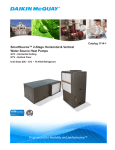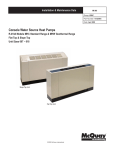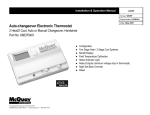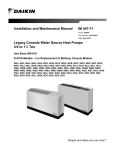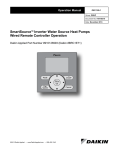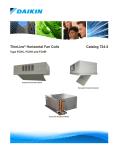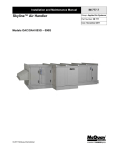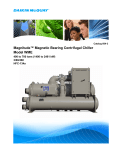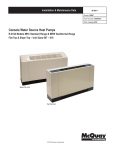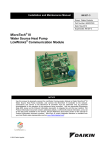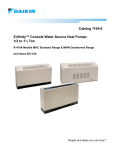Download McQuay LIA266 Specifications
Transcript
Installation & Maintenance Data IM 1060-3 Group: WSHP Part Number: 669479203 Date: May 2012 Enfinity™ Large Horizontal Water Source Heat Pumps with R-410A Refrigerant Horizontal Models CCH Standard Range & CCW Geothermal Range Unit Sizes 072 – 120 (6 to 10 Tons) • R-410A Refrigerant ©2012 McQuay International • 800.432.1342 • www.daikinmcquay.com Contents Nomenclature.......................................................................2 Antifreeze Correction Factors...........................................12 ...............................................................................................2 MicroTech® III Controller....................................................13 Receiving and Storage.........................................................3 Pre-Installation...................................................................3 MicroTech III Operating Features......................................14 Pre-Installation.....................................................................4 Air Discharge Conversion Procedure................................4 Estimated Time:.................................................................4 MicroTech® III Controller with LonWorks® or BACnet Communication Module.....................................................16 MicroTech III LonWorks Communication Module............16 MicroTech III BACnet Communication Module................16 MicroTech III Controller with Communication Modules Features..........................................................................16 I/O Expansion Module........................................................15 Installation.............................................................................5 Unit Location......................................................................5 Filter Access......................................................................5 Installation.............................................................................6 Air Balancing.....................................................................6 Sheave Adjustment............................................................6 Thermostat Connections...................................................22 Optional Remote Sensor (P/N 66720401).......................22 MicroTech III Wall-Mounted Room Temperature Sensors . .........................................22 Wiring Sensors to the MicroTech III Controller................23 2-Way Motorized Isolation Valve.....................................23 Motorized Valve/Pump Restart Output............................25 Multiple Unit Control (up to 3 units) (P/N 056794201) ....25 Ductwork & Attenuation.......................................................7 Ventilation Air.....................................................................8 Electrical Data.......................................................................8 General..............................................................................8 230-Volt Operation.............................................................8 Troubleshooting.................................................................26 The in and outs of R-410A...............................................26 Lubrication.......................................................................26 Charging..........................................................................26 General Maintenance......................................................26 Typical Cooling Refrigeration Cycle – Dual Compressors...........................................................28 Typical Heating Refrigeration Cycle – Dual Compressors...........................................................29 Piping.....................................................................................9 Cleaning & Flushing System.............................................10 Start-up................................................................................10 Operating Limits.................................................................11 Environment.................................................................... 11 Additional Information For Initial Start-up Standard Range units CCH........................................................................12 Geothermal Range units CCW........................................12 Operating Voltages..........................................................12 Nomenclature W CCH 1 120 W = WSHP F S Y Y Y Y = None Product Identifier Reserved CCH = Large Horizontal - Standard Range CCW = Large Horizontal - Geothermal 1 = A Design 2 = B Design 3 = C Design L Current Sensing Product Category Design Series B Y = None Reserved Y = None 4 = D Design 5 = E Design Condensate Overflow S = Standard Overflow Sensor Nominal Capacity 072 = 72,000 BTU/h 096 = 96,000 BTU/h 120 = 120,000 BTU/h Voltage D F H K L N Controls B = MicroTech® III A = DDC Less Board = 208-60-3 = 208/230-60-3 = 230-60-3 = 460-60-3 = 575-60-3 = 380-50-3 Network Module Option L = LonWorks® Module B = BACnet® Module Y = None Page 2 of 32 / IM 1060-3 Note: For illustration purposes only. Not all options available with all models. Please consult Daikin McQuay Sales Representative for specific availability. Receiving and Storage CAUTION Sharp edges can cause personal injury. Avoid contact with them. Use care and wear protective clothing, safety glasses and gloves when handling parts and servicing heat pumps. Upon receipt of the equipment, check carton for visible damage. Make a notation on the shipper’s delivery ticket before signing. If there is any evidence of rough handling, immediately open the cartons to check for concealed damage. If any damage is found, notify the carrier within 48 hours to establish your claim and request their inspection and a report. The Warranty Claims Department should then be contacted. Do not stand or transport the machines on end. For storing, each carton is marked with “up” arrows. In the event that elevator transfer makes up-ended positioning unavoidable, do not operate the machine until it has been in the normal upright position for at least 24 hours. Temporary storage at the job site must be indoor, completely sheltered from rain, snow, etc. High or low temperatures naturally associated with weather patterns will not harm the units. Excessively high temperatures, 140°F (60°C) and higher, may deteriorate certain plastic materials and cause permanent damage. IMPORTANT IMPORTANT This product was carefully packed and thoroughly inspected before leaving the factory. Responsibility for its safe delivery was assumed by the carrier upon acceptance of the shipment. Claims for loss or damage sustained in transit must therefore be made upon the carrier as follows: VISIBLE LOSS OR DAMAGE Any external evidence of loss or damage must be noted on the freight bill or carrier’s receipt, and signed by the carrier’s agent. Failure to adequately describe such external evidence of loss or damage may result in the carrier’s refusal to honor a damage claim. The form required to file such a claim will be supplied by the carrier. CONCEALED LOSS OR DAMAGE Pre-Installation WARNING WARNING The installer must determine and follow all applicable codes and regulations. This equipment presents hazards of electricity, rotating parts, sharp edges, heat and weight. Failure to read and follow these instructions can result in property damage, severe personal injury or death. This equipment must be installed by experienced, trained personnel only. 1. To prevent damage, do not operate this equipment for supplementary heating and cooling during the construction period. 2. Inspect the carton for any specific tagging numbers indicated by the factory per a request from the installing contractor. At this time the voltage, phase and capacity should be checked against the plans. 3. Check the unit size against the plans to verify that the unit is being installed in the correct location. 4. Before installation, check the available ceiling height versus the height of the unit. 5. Note the location and routing of water piping, condensate drain piping, and electrical wiring. The locations of these items are clearly marked on submittal drawings. 6. The installing contractor will find it beneficial to confer with piping, sheet metal, and electrical foremen before installing any unit. Note: Check the unit data plate for correct voltage with the plans before installing the equipment. Also, make sure all electrical ground connections are made in accordance with local code. 7. The contractor shall cover the units to protect the machines during finishing of the building. This is critical while spraying fireproofing material on bar joists, sandblasting, spray painting and plastering. If plastic film is not available, the shipping carton may be modified to cover the units during construction. 8. Remove all shipping blocks in the fan wheel. 9. Change the airflow direction from straight discharge to end discharge or vice versa before the unit is installed in the ceiling. Refer to the page 4 for Air Discharge Conversion Instructions. Concealed loss or damage means loss or damage which does not become apparent until the product has been unpacked. The contents may be damaged in transit due to rough handling even though the carton may not show external damages. When the damage is discovered upon unpacking, make a written request for inspection by the carrier’s agent within fifteen (15) days of the delivery date and file a claim with the carrier. IM 1060-3 / Page 3 of 32 Pre-Installation Air Discharge Conversion Procedure Unit sizes 072 thru 120 straight discharge unit may be converted to an end discharge by doing the following: Note: No additional parts are required to perform this rework. The rework must not be performed while unit is in the ceiling, but on the floor or a work bench. Estimated Time: 1 Hour CAUTION Sharp edges can cause personal injury. Avoid contact with them. Use care and wear protective clothing, safety glasses and gloves when handling parts and servicing heat pumps. 1. Remove the top (A) and the end access panel (B) 2. Loosen the belt tension brackets (C) and roll the drive belt off the blower pulley and the adjustable sheave. 3. Remove the fixed pulley on the blower fan shaft. 4. Remove the four bolts (D) holding the blower housing in place to the unit base or bottom (2 each side). 5. Remove the blower discharge panel mounting screws holding it in place to the corner post and side post. 6. With the all bolts and screws removed, lift out the blower assembly and place it on a workbench. Figure 1: Details for Making Fan Blower Conversion 7. Remove the nuts, bolts and washers (C & E) that are holding the adjustable fan motor plate (F) to the blower housing. There are four sets of nuts, bolts and washers. 8. Rotate the motor and motor plate over end for end 180º putting the fan motor shaft on the opposite side of the blower housing. Reposition the nuts, bolts and washers that hold the motor plate and motor, leaving the adjustable nuts (C) loose for readjustment. 9. Remove the grease fitting tube (G) from the coupling tube (H). Remove the other end of the grease tube (G) at the coupling (J). Also remove the grease tube end (K). Save all for reinstallation. 10. Remove the fan shaft as one complete assembly and reinstall it from the opposite side of the housing assembly. Reassemble the motor mounting plate (F). 12. Reinstall in reverse order as in step 9 the grease tube (G). Note: The tube must be pushed through the bushing in the blower housing plate prior to coupling (J) and end fitting (K) are reattached. 13. Center the fan in the housing. Set the bearings (Detail “A”) and proper belt tension by referring to "Air Balancing" on page 6. WARNING WARNING Do not overtighten the belt tension. Belts that are overtightened are the leading cause of blower assembly failure. 14. Lift the completed belt-drive blower assembly and locate it over the holes in the base pan. The belt and pulleys should now be facing the repositioned access panel (B). 15. Reinstall the access panels, power the unit and operate the blower to confirm proper fan rotation. A Figure 2: Unit Converted to End Discharge C Grease Fitting Tube F E D B K B J G Motor and Fan Rotation Blower Discharge Panel (End Discharge) H Bearing Set Screw Must Be Tightened Against Fan Shaft with Torque of 5.5 Ft./Lbs. Page 4 of 32 / IM 1060-3 Installation Unit Location 1. Locate the unit in an area that allows for easy removal of the filter and access panels. Leave a minimum of 18" of clearance around the heat pump for easy removal, and to perform routine maintenance, or troubleshooting. Provide sufficient room to make water, electrical and duct connections. 2. The contractor should make sure that adequate ceiling panel access exists, including clearance for hanger brackets, duct collars and fittings at water and electrical connections. 3. Allow adequate room below the unit for a condensate trap and do not locate the unit above pipes. 4. Each unit is suspended from the ceiling by four threaded rods. The rods are attached to the unit corners by a hanger bracket through a rubber isolator. 7. Leave minimum 3" (76 mm) extra threaded rod below the double nuts or minimum 3" (76 mm) clearance between top of unit and ceiling above to facilitate top panel removal for servicing. Filter Access Each unit is shipped with a 2" filter bracket for side filter removal. For bottom removal push the filter up into top bracket to gain clearance of bottom bracket and remove the filter. Also, a sheet metal duct filter retainer can be fabricated when return air duct work is used. Figure 4: Filter Rack/Return Air Duct Collar D C CAUTION Do not use rods smaller than shown in Figure 3. The rods must be securely anchored to the ceiling or to the bar joists. 5. Each unit is furnished with a hanger kit. The kit is shipped unassembled and includes hanger brackets, rubber isolators, washers, bolts and lock washers. Lay out the threaded rods per the dimension in Figure 3. 6. When attaching the hanger rods to the unit, a double nut is recommended since vibration could loosen a single nut. The installer is responsible for providing the hex nuts when installing hanger rods. B A E Figure 3: Hanger Brackets - Sizes 072 thru 120 2" (51 mm) Fan Assembly Comp. 42" (1067 mm) Comp. 44" (1118 mm) By Others By McQuay International Control Box Coil 2" (51 mm) Airflow 5/8" Threaded Rod (By Others) 80" (2032 mm) 82" (2082 mm) IM 1060-3 / Page 5 of 32 Table 1: 60 Hz Unit - Sheave Adjustment Installation Air Balancing Unit sizes 072 thru 120 are supplied with a variable pitch motor sheave to aid in airflow adjustment. They are set at the factory as shown in Table 1. When the final adjustments are complete, the current draw of the motors should be checked and compared to the full load current rating of the motors. The amperage must not exceed the service factor stamped on the motor nameplate. Upon completion of the air balance, it is a common industry recommendation that the variable pitched motor sheave be replaced with a properly sized fixed sheave. A matching fixed sheave will provide longer belt and bearing life and vibration free operation. Initially, it is best to have a variable pitched motor sheave for the purpose of air balancing, but once the balance has been achieved, fixed sheaves maintain balancing and alignment more effectively. Sheave Adjustment (See Figure 5) 1. All sheaves should be mounted on the motor or driving shaft with the setscrew “A” toward the motor 2. Be sure both driving and driven sheaves are in alignment and that shafts are parallel. 3. Fit internal key “D” between sheave and shaft, and lock setscrew “A” securely in place. Adjusting 1. Loosen setscrews “B” and “C” in moving parts of sheave and pull out external key “E”. (This key projects a small amount to provide a grip for removing.) Figure 5: Sheave Adjustment Detail A B Unit Size Motor HP RPM Range 1½ 756-902 072 3 907-1081 1½ 698-832 096 3 907-1081 3 756-901 120 5 907-1081 Motor Sheave Position 4-Turns Open 5-Turns Open 1½-Turns Open 5-Turns Open 3-Turns Open 5-Turns Open 2. Adjust sheave pitch diameter for desired speed by opening moving parts by half or full turns from closed position. Do not open more than five full turns. 3. Replace external key “E” and securely tighten setscrews “B” over key and setscrews “C” into keyway in fixed half of the sheave. 4. Put on belts and adjust belt tension to 4 lbs. – 0.7 lbs. (18N – 3N) for a 1⁄2" to 3⁄4" (13 mm to 19 mm) belt deflection height. 5. To determine the deflection distance from normal position, use a straightedge or stretch a cord from sheave to sheave to use as a reference line. On multiple-belt drives an adjacent undeflected belt can be used as a reference. 6. Future adjustments should be made by loosening the belt tension and increasing or decreasing the pitch diameter of the sheave by half or full turns as required. Readjust belt tension before starting drive. 7. Be sure that all keys are in place and that all setscrews are tight before starting drive. Setscrews and belt tension must be checked after 24 hours of operation. 8. When new V-belts are installed on a drive, the initial tension will drop rapidly during the first few hours. Check tension frequently during the first 24 hours of operation. Subsequent retensioning should fall between the minimum and maximum force. Figure 6: Drive Belt Adjustmment Span Le ngth (t) E D Factory Settings (RPM) 785 904 858 904 814 904 Deflecti on Force Key E projects to provide a grip for removing D h C d Single Groove C t h= 64 t= Page 6 of 32 / IM 1060-3 C2 - ( ) D-d 2 Where: t = Span length, inches (mm) C = Center distance, inches (mm) d = Smaller sheave diameter, inches (mm) h = Deflection height, inches (mm) Note: The ratio of deflection to belt span is 1:64. Table 2: 50 Hz Unit - Sheave Adjustment Unit Size Motor HP RPM Range 072 1½ 756-901 096 1½ 720-860 120 3 756-902 Factory Settings (RPM) 786 858 815 Motor Sheave Position 4-Turns Open 1½-Turns Open 3-Turns Open Ductwork & Attenuation Table 3: Filter Rack/Return Air Duct Collar Dimensions Unit Size 072 A 45.12" (1146mm) B 26.53" (674mm) C 3.20" (81mm) D 1.82" (46mm) E 1.50" (38mm) 096 55.12" (1400mm) 26.53" (674mm) 3.20" (81mm) 1.82" (46mm) 1.50" (38mm) 120 55.12" (1400mm) 26.53" (674mm) 3.20" (81mm) 1.82" (46mm) 1.50" (38mm) Discharge ductwork is normally used with these conditioners. Return air ductwork may also be required. All ductwork should conform to industry standards of good practice as described in the ASHRAE Systems Guide. The discharge duct system will normally consist of a flexible connector at the unit, a transition piece to the full duct size, a short run of duct and a trunk duct teeing into a branch duct with discharge diffusers as shown in Figure 7. The transition piece must not have angles totaling more than 30° or severe loss of air performance can result. Do not connect the full duct size to the unit without using a transition piece down to the size of the discharge collar on the unit. With metal duct material, the sides only of the elbow and entire branch duct should be internally lined with acoustic fibrous insulation for sound attenuation. Glass fiber duct board material is more absorbing and may permit omission of the canvas connector. As a general recommendation, the acoustic fibrous insulation should be at least 1/2 inch thick over the entire duct run (Figure 7). For better sound attenuation, line the last five diameters of duct before each register with a one-inch thick sound blanket. Elbows, tees and dampers can create turbulence or distortion in the airflow. Place a straight length of duct, 5 to 10 times the duct width, before the next fitting to smooth out airflow. Diffusers that are located in the bottom of a trunk duct can also produce noise. For this same reason, volume control dampers should be located several duct widths upstream from an air outlet. For Hotel, Motel, Dormitory or Nursing Home applications that use a single duct discharge, a velocity of 500 to 600 fpm is suggested. These applications typically have static pressures as low as 0.05 inches of water and duct lengths approximately six feet in length. The discharge duct must be fully lined and have a square elbow without turning vanes. Return air ductwork can be connected to the standard filter rack. See Figure 4 on page 5 (side filter removal shown). The filter rack can be installed for bottom filter removal or side filter removal by locating the brackets. For side filter removal the brackets should be located on the bottom, left side, and top. For bottom filter removal the brackets should be mounted on the left side top and right side with the spring clips supporting the filter. Do not use sheet metal screws directly into the unit cabinet for connection of supply or return air ductwork, especially return air ductwork which can hit the drain pan or the air coil. Return air for these applications should enter through a “low” sidewall filter grille and route up the stud space to a ceiling plenum. For horizontal heat pumps mounted from the ceiling, an insulated return plenum is sometimes placed at the return air opening to further attenuate line-of-sight sound transmission through return openings. Figure 7: Suggested Supply Ducting per ASHRAE and SMACNA Publications Flexible Connector Ductwork Supported Independent of Unit Acoustic/Thermal Lining 3ft. (.9m) to 5ft. (1.5m) Acoustic/Thermal Lining Diffuser Diffuser Two 90° Turns (Ductwork Sized Based on Airflow) IM 1060-3 / Page 7 of 32 Figure 8: Suggested Return Ducting per ASHRAE and SMACNA Publications Two 90° Turns Prior to the Intake (Ductwork Sized Based on Airflow) Flexible Connector Acoustic/Thermal Lining Acoustic/Thermal Lining Ductwork Supported Independent of Unit Acoustic/Thermal Lining 10ft. (3 meters) Return Air Intake Located Away from the Unit Blower Flexible Connector Ventilation Air Ventilation may require outside air. The temperature of the ventilation air must be controlled so that mixture of outside air and return air entering the conditioner does not exceed conditioner application limits. It is also typical to close off the ventilation air system during unoccupied periods (night setback). The ventilation air system is generally a separate building subsystem with distribution ductwork. Simple introduction of the outside air into each return air plenum chamber reasonably close to the conditioner air inlet is not only adequate, but recommended. Do not duct outside air directly to the conditioner inlet. Provide sufficient distance for thorough mixing of outside and return air. See "Operating Limits" on page 11. and/or a 1-1⁄8" (29 mm) knockout is supplied on the side of the unit. A disconnect switch near the unit is required by code. Power to the unit must be sized correctly and have dual element (Class RK5) fuses or an HACR circuit breaker for branch circuit overcurrent protection. See the nameplate for correct ratings. 3. Three phase 50 cycle units, 380/50-3, require a neutral wire for 230/50-1 power to the fan circuit. 4. Connect the thermostat/subbase wiring with the power “off ” to the unit. 5. Field supplied relays installed on the input terminals W1, W2, Y1, Y2 or G may introduce electrical noise. Never install relay coils in series with the inputs. Electrical Data 230-Volt Operation General All 208/230-volt three-phase units are factory wired for 208volt operation. For 230-volt operation, the line voltage tap on the 24-volt transformer must be changed. Disconnect and cap the red lead wire and interchange it with the orange lead wire on the primary of the 24-volt transformer. 1. Verify the compatibility between the voltage and phase of the available power and that shown on the unit serial plate. Line and low voltage wiring must comply with local codes or the National Electrical Code, whichever applies. 2. Apply correct line voltage to the unit. A 7⁄8" (22mm) hole Table 4: Electrical Data Unit Size Voltage/Hz/Phase 208/230-60-3 460-60-3 072 575-60-3 380-50-3 208/230-60-3 460-60-3 096 575-60-3 380-50-3 208/230-60-3 460-60-3 120 575-60-3 380-50-3 Page 8 of 32 / IM 1060-3 FanCompressor 1 Motor (HP) RLA LRA 1.5 1.5 1.5 1.5 1.5 1.5 1.5 1.5 3 3 3 3 14.7 6.6 4.6 6.6 15.3 6.9 5.4 6.8 17.4 8.6 6.5 8.6 88.0 44.0 30.0 46.0 83.1 41.0 33.0 43.0 110.0 52.0 38.9 51.5 Compressor 2 RLA LRA 14.7 6.6 4.6 6.6 15.3 6.9 5.4 6.8 17.4 8.6 6.5 8.6 88.0 44.0 30.0 46.0 83.1 41.0 33.0 43.0 110.0 52.0 38.9 51.5 Fan Motor FLA Total Unit FLA Minimum Voltage Minimum Circuit Amps Maximum Fuse Size 5.6 2.8 2.3 3.4 5.6 2.8 2.0 3.4 9.5 4.5 3.4 4.8 35.0 16.0 11.5 16.6 36.2 16.6 12.8 17.0 44.3 21.7 16.4 22.0 187.0 416.0 520.0 342.0 187.0 416.0 520.0 342.0 187.0 416.0 520.0 342.0 38.7 17.7 12.7 18.3 40.0 18.3 14.2 18.7 48.7 23.9 18.0 24.2 50 20 15 20 50 25 15 25 60 30 20 30 Piping 1. All units should be connected to supply and return piping in a two-pipe reverse return configuration. A reverse return system is inherently self-balancing and requires only trim balancing where multiple quantities of units with different flow and pressure drop characteristics exist in the same loop. Check for proper water balance by measuring differential temperature reading across the water connections. To insure proper water flow, the differential flow should be 10°F to 14°F (5°C to 8°C) for units in cooling mode. A direct return system may also work acceptably, but proper water flow balancing is more difficult to achieve and maintain. 2. The piping can be steel, copper or PVC. 3. Supply and return runouts usually join the unit via short lengths of high pressure flexible hose which are sound attenuators for both unit operating noise and hydraulic pumping noise. One end of the hose should have a swivel fitting to facilitate removal for service. Hard piping can also be brought directly to the unit. This option is not recommended since no vibration or noise attenuation can be accomplished. The hard piping must have unions to facilitate unit removal. See Figure 9 for typical piping setup. Figure 9: Typical Piping Electrical Access Panel Hanger Kits (4) Flex Hoses Return Riser 4. Some flexible hose threaded fittings are supplied with sealant compound. If not, apply Teflon tape to assure a tight seal. 5. Supply and return shutoff valves are required at each conditioner. The return valve is used for balancing and should have a “memory stop” so that it can always be closed off but can only be reopened to the proper position for the flow required. 6. No unit should be connected to the supply and return piping until the water system has been cleaned and flushed completely. After the cleaning and flushing has taken place, the initial connection should have all valves wide open in preparation for water system flushing. 7. Condensate piping can be steel, copper or PVC. Each unit includes a condensate connection. 8. The condensate disposal piping must have a trap.The piping must be pitched away from the unit not less than 1⁄4" per foot (21 mm per meter) (see Figure 10). Generally, the condensate trap is made of copper and soldered on the unit. A piece of vinyl hose from the trap to the drain line is used for simple removal. A complete copper or PVC condensate system can also be used. Union fittings in the copper lines should be applied to facilitate removal. Factory supplied condensate hose assemblies have pipe thread fittings to facilitate connection of a flexible vinyl or steel braided hose. 9. Do not locate any point in the drain system above the drain connection of any unit. 10. Automatic flow controlled devices must not be installed prior to system cleaning and flushing. 11. A high point of the piping system must be vented. 12. Check local code for the need for dielectric fittings. Figure 10: Typical Condensate Piping Condensate Riser Ball Valves Supply Air Supply Riser 11⁄2" (38 mm) 11⁄2" (38 mm) Optional Field Installed Vent 1⁄4" Per Foot (21 mm Per Meter) IM 1060-3 / Page 9 of 32 Cleaning & Flushing System 1. Prior to first operation of any conditioner, the water circulating system must be cleaned and flushed of all construction dirt and debris. If the conditioners are equipped with water shutoff valves, either electric or pressure operated, the supply and return runouts must be connected together at each conditioner location. This will prevent the introduction of dirt into the unit. See Figure 11. Figure 11: Supply & Return Runouts Connected Together Return Runout Supply Runout Mains Flexible Hose Runouts Initially Connected Together 5. Refill the system with clean water. Test the water using litmus paper for acidity, and treat as required to leave the water slightly alkaline (pH 7.5 to 8.5). The specified percentage of antifreeze may also be added at this time. Use commercial grade antifreeze designed for HVAC systems only. Do not use automotive grade antifreeze. Once the system has been filled with clean water and antifreeze (if used), precautions should be taken to protect the system from dirty water conditions. Dirty water will result in system wide degradation of performance and solids may clog valves, strainers, flow regulators, etc. Additionally, the heat exchanger may become clogged which reduces compressor service life or causes premature failure. 6. Set the loop water controller heat add setpoint to 70°F (21°C) and the heat rejection setpoint to 85°F (29°C). Supply power to all motors and start the circulating pumps. After full flow has been established through all components including the heat rejector (regardless of season) and air vented and loop temperatures stabilized, each of the conditioners will be ready for check, test and start-up, air balancing, and water balancing. Start-up 2. Fill the system at the city water makeup connection with all air vents open. After filling, close all air vents. The contractor should start main circulator with the pressure reducing valve open. Check vents in sequence to bleed off any trapped air, ensuring circulation through all components of the system. Power to the heat rejector unit should be off, and the supplementary heat control set at 80°F (27°C). While circulating water, the contractor should check and repair any leaks in the piping. Drains at the lowest point(s) in the system should be opened for initial flush and blowdown, making sure city water fill valves are set to make up water at the same rate. Check the pressure gauge at pump suction and manually adjust the makeup to hold the same positive steady pressure both before and after opening the drain valves. Flush should continue for at least two hours, or longer if required, to see clear, clean drain water. 3. Shut off supplemental heater and circulator pump and open all drains and vents to completely drain down the system. Short circuited supply and return runouts should now be connected to the conditioner supply and return connections. Do not use sealers at the swivel flare connections of hoses. 4. Trisodium phosphate was formerly recommended as a cleaning agent during flushing. However, many states and localities ban the introduction of phosphates into their sewage systems. The current recommendation is to simply flush longer with warm 80°F (27°C) water. Page 10 of 32 / IM 1060-3 1. Open all valves to full open position and turn on power to the conditioner. 2. Set thermostat for “Fan Only” operation by selecting “Off” at the system switch and “On” at the fan switch. If “Auto” fan operation is selected, the fan will cycle with the compressor. Check for proper air delivery. 3. For those units that have two-speed motors, reconnect for low speed operation if necessary. 4. Set thermostat to “Cool.” If the thermostat is an automatic changeover type, simply set the cooling temperature to the coolest position. On manual changeover types additionally select “Cool” at the system switch. Again, many conditioners have time delays which protect the compressor(s) against short cycling. After a few minutes of operation, check the discharge grilles for cool air delivery. Measure the temperature difference between entering and leaving water. It should be approximately 1½ times greater than the heating mode temperature difference. For example, if the cooling temperature difference is 15°F (8°C), the heating temperature difference should have been 10°F (5°C). Without automatic flow control valves, target a cooling temperature difference of 10°F to 14°F (5°C to 8°C). Adjust the combination shutoff/balancing valve in the return line to a water flow rate which will result in the 10˚F to 14°F (5°C to 8°C) difference. 5. Set thermostat to “Heat.” If the thermostat is the automatic changeover type, set system switch to the “Auto” position and depress the heat setting to the warmest selection. Some conditioners have built-in time delays which prevent the compressor from immediately starting. With most control schemes, the fan will start immediately. After a few minutes of compressor operation, check for warm air delivery at discharge grille. If this is a “cold building” start-up, leave unit running until return air to the unit is at least 65°F (18°C). Measure the temperature difference between entering and leaving air and entering and leaving water. With entering water of 60°F to 80°F (16°C to 27°C), leaving water should be 6°F to 12°F (3.3°C to 6.6°C) cooler, and the air temperature rise through the machine should not exceed 35°F (19°C). If the air temperature exceeds 35°F (19°C), then the water flow rate is inadequate. 6. Check the elevation and cleanliness of the condensate line. If the air is too dry for sufficient dehumidification, slowly pour enough water into the condensate pan to ensure proper drainage. 7. If the conditioner does not operate, check the following points: a. Is supply voltage to the machine compatible? b. Is thermostat type appropriate? c. Is thermostat wiring correct? 8. If the conditioner operates but stops after a brief period: a. Is there proper airflow? Check for dirty filter, incorrect fan rotation (3-phase fan motors only), or incorrect ductwork. b. Is there proper water flow rate within temperature limits? Check water balancing; backflush unit if dirtclogged. 9. Check for vibrating refrigerant piping, fan wheels, etc. 10. Do not lubricate the fan motor during the first year of operation as it is prelubricated at the factory. 11. Field supplied relays installed on the input terminals W1, W2, Y1, Y2 or G may introduce electrical noise. Never install relay coils in series with the inputs. Operating Limits Environment This equipment is designed for indoor installation only. Sheltered locations such as attics, garages, etc., generally will not provide sufficient protection against extremes in temperature and/or humidity, and equipment performance, reliability, and service life may be adversely affected. Table 4: Air Limits - °F (English units) Standard Range Units Cooling Heating Min. Ambient Air 50ºF 50ºF Normal Ambient Air 80ºF 70ºF Max Ambient Air 100ºF 85ºF Min. Entering Air 1,2 50ºF 50ºF Normal Entering Air db/wb 80/67ºF 70ºF Max Entering Air db/wb 1,2 100/83ºF 80ºF Geothermal Range Units Cooling Heating 40ºF 40ºF 80ºF 70ºF 100ºF 85ºF 50ºF 40ºF 80/67ºF 70ºF 100/83ºF 80ºF Table 5: Air Limits - °C (SI units) Min. Ambient Air Normal Ambient Air Max Ambient Air Min. Entering Air 1,2 Normal Entering Air db/wb Max Entering Air db/wb 1,2 Standard Range Units Cooling Heating 10ºC 10ºC 27ºC 21ºC 38ºC 29ºC 10ºC 10ºC 27/19ºC 21ºC 38/28ºC 27ºC Geothermal Range Units Cooling Heating 5ºC 5ºC 27ºC 21ºC 38ºC 29ºC 10ºC 5ºC 27/19ºC 21ºC 38/28ºC 27ºC Table 6: Water - °F (English units) Min. Entering Water 1,2 Normal Entering Water Max Entering Water Standard Range Units Cooling Heating 55ºF 55ºF 85ºF 70ºF 110ºF 90ºF Geothermal Range Units Cooling Heating 30ºF 20ºF 77ºF 40ºF 110ºF 90ºF Table 7: Water - °C (SI units) Standard Range Units Cooling Heating Min. Entering Water 1,2 Normal Entering Water Max Entering Water 13ºC 29ºC 43ºC 13ºC 21ºC 32ºC Geothermal Range Units Cooling Heating -1ºC 25ºC 43ºC -6ºC 4ºC 32ºC Notes: 1. At ARI flow rate. 2. Maximum and minimum values may not be co bined. If one value is at maximum or minimum, the other two conditions may not exceed the normal condition for standard units. Extended range units may combine any two maximum or minimum conditions, but not more than two, with all other conditions being normal conditions. IM 1060-3 / Page 11 of 32 Additional Information For Initial Start-up Standard Range units CCH Units are designed to start-up in an ambient of 50°F (10°C), with entering air at 50°F (10°C), with entering water at 70°F (21°C), with both air and water flow rates used in the ISO 13256-1 rating test, for initial start-up in winter. Note: This is not a normal or continuous operating condition. It is assumed that such a start-up is for the purpose of bringing the building space up to occupancy temperature. Geothermal Range units CCW Geothermal heat pump units are designed to start-up in an ambient of 40°F (5°C), with entering air at 40°F (5°C), with entering water at 25°F (-4°C), with both air and water at flow rates used in the ISO 13256-1 rating test, for initial start-up in winter. Note: Operating Voltages 115-60-1...................104 volts min.; 127 volts max. 208/230-60-1............197 volts min.; 253 volts max. 265-60-1...................238 volts min.; 292 volts max. 230-50-1...................197 volts min.; 253 volts max. 460-60-3...................414 volts min.; 506 volts max. 380-50-3...................342 volts min.; 418 volts max. 575-60-3...................515 volts min.; 632 volts max. Note: Voltages listed are to show voltage range. However, units operating with overvoltage and undervoltage for extended periods of time will experience premature component failure. Three phase system unbalance should not exceed 2%. This is not a normal or continuous operating condition. It is assumed that such a start-up is for the purpose of bringing the building space up to occupancy temperature. Antifreeze Correction Factors Table 1: Ethylene Glycol Cooling Capacity Heating Capacity Pressure Drop 10% 0.9950 0.9910 1.0700 20% 0.9920 0.9820 1.1300 30% 0.9870 0.9770 1.1800 40% 0.9830 0.9690 1.2600 50% 0.9790 0.9610 1.2800 10% 0.9900 0.9870 1.0700 20% 0.9800 0.9750 1.1500 30% 0.9700 0.9620 1.2500 40% 0.9600 0.9420 1.3700 50% 0.9500 0.9300 1.4200 10% 0.9980 0.9950 1.0230 20% 0.9720 0.9700 1.0570 30% – – – 40% – – – 50% – – – 10% 0.9910 0.9950 1.0350 20% 0.9510 0.9600 0.9600 30% – – – 40% – – – 50% – – – Table 2: Propylene Glycol Cooling Capacity Heating Capacity Pressure Drop Table 3: Methanol Cooling Capacity Heating Capacity Pressure Drop Table 4: Ethanol Cooling Capacity Heating Capacity Pressure Drop Page 12 of 32 / IM 1060-3 MicroTech® III Controller The control enclosure houses the major operating electrical controls including the MicroTech® III controller and I/O expansion module, control transformer, compressor relays and fan relay. Each component is easily accessed for service or replacement. Three unique control choices are offered with the MicroTech III control system: ■ Standalone operation using a MicroTech III controller and I/O expansion module ■ MicroTech III controller with I/O expansion module and LonWorks® communication module ■ MicroTech III controller with I/O expansion module and BACnet® communication module Each option features direct quick-connect wiring to all unitcontrolled components for “clean” wiring inside the control box. Each control circuit board receives power from a 75 VA transformer. Figure 12: Control Options Control MicroTech III (Standalone) Unit Controller with I/O Expansion Module LonWorks Communication Module BACnet Communication Module Description Application Protocol The MicroTech III controller is a standalone microprocessor-based control board conveniently located in the unit control enclosure for easy accessibility. The board is designed to provide thermostat control of a Water Source Heat Pump using a two-stage wall thermostat. The unit controller provides unit-wide control of the WSHP and control of the first refrigerant circuit. Each unit controller is factory programmed, wired, and tested for complete control of single zone, standalone operation of your Daikin McQuay Water Source Heat Pump. Unit-mounted or wallmounted thermostat The I/O Expansion Module is an extension of the Microtech III controller and provides control of the second refrigerant circuit. External LED status lights display fault conditions to provide easy troubleshooting and diagnosis of the second circuit. Allows for: • Control of second refrigeration circuit. Wall-mounted thermostat or sensor The MicroTech III control system accepts a plug-in LonWorks commu nication module to provide network communications and added functionality to easily integrate with an existing BAS. The communication module can be factory- or field-installed and is tested with all logic required to monitor and control the unit. Designed to be linked with a centralized building automation system (BAS) through a LonWorks com munications network for centralized scheduling and management of multiple heat pumps. LonMark 3.4 certified The MicroTech III controller accepts a plug-in BACnet commun ication module to provide network communications and added functionality to easily integrate with an existing BAS. The communication module can be factory- or field-installed and is tested with all logic required to monitor and control the unit. Designed to be linked with a centralized building automation system (BAS) through a BACnet communications network for centralized scheduling and management of multiple heat pumps. BACnet MS/TP IM 1060-3 / Page 13 of 32 The MicroTech III Controller is a microprocessor-based control board conveniently located in the unit control box for easy access through a removable access panel. The standalone unit controller is a hard wired interface and provides all the necessary field connections. The board can be wired for 24volt AC output to the wall thermostat by using terminals R & C. An LED annunciator is located on the front of the unit chassis to allow quick check of the unit operating status. MicroTech III Operating Features Assumes cycle fan operation-not continuous fan operation: ■ Start-up – The unit will not operate until all the inputs and safety controls are checked for normal conditions. ■ Cooling mode – On a call for cooling from the wall thermostat, the controller will energize the fan relay and stage compressors to satisfy the space temperature setpoint. When the load is satisfied, the controller will disable the compressor and fan. ■ Heating Mode – On a call for heating from the wall thermostat, the controller will enable the fan, energize circuit one reversing valve and circuit 1 compressor to satisfy the space heating setpoint. If the space temperature setpoint is not satisfield, circuit two reversing valve and circuit 2 compressor will be energized and run until the heating setpoint at the thermostat is satisfied. ■ Random Start Power-up Delay Timer – In the event of a building power outage, this feature prevents multiple units from starting simultaneously upon building power restoration. ■ Unoccupied Mode – A simple “grounded” signal between terminals U and C (no power source required), puts the unit into the unoccupied mode for night setback operation. ■ Interstaging Timer – A default value of 5 minutes between staging of compressors, this feature minimizes short cycling of compressors and improves comfort. ■ Override Mode – A switch on the deluxe automatic changeover thermostat can be activated during the unoccupied mode to put the unit back into the occupied mode for two hours for after-hours heating or cooling. ■ Motorized Valve/Pump Restart – The IV/PR (H8) terminals on the The MicroTech III unit controller are used to energize (open) a motorized valve or start a water pump to get water circulating prior to starting the compressor on call for heating or cooling. The IV/PR (H8) terminal may be “daisy chained” between a maximum of 200 units. ■ Brownout Protection – The MicroTech III unit controller measures the input voltage and will suspend compressor and fan operation if the voltage falls below 80% of the unit nameplate rated value. A unique LED status is generated. ■ Unit Shutdown – A simple grounded signal puts the unit into the shutdown mode. Compressor and fan operations are suspended. A unique LED status is generated. ■ Condensate Overflow Protection – The MicroTech III controller incorporates a liquid sensor at the top of the drain pan. Upon sensing water flow, cooling operation is suspended. A unique LED status is generated. ■ Remote Reset of Automatic Lockouts – The Remote Reset feature provides the means to remotely reset automatic lockouts generated by high-pressure and/or low-temperature faults. When the MicroTech III controller is in automatic lockout due to one of these faults, and the cause of the fault condition has been alleviated, energizing the O-terminal for 10 seconds or more will force the control board to clear the lockout. A unit power cycle can also be used to clear an automatic lockout if the conditions causing the fault have been alleviated. ■ Intelligent Reset – The Fault Retry feature helps to minimize nuisance trips of automatic lockouts caused by high-pressure and/or low-temperature faults. This feature clears faults the first two times they occur within a 24hour period and triggers an automatic lockout on the 3rd fault. The retry count is reset to zero every 24 hours. ■ Equipment Protection Control – The MicroTech III controller receives separate input signals from the refrigerant high-pressure switch and the low suction line temperature sensor. In a high-pressure situation, compressor operation is suspended. In a low temperature situation, the unit goes into a defrost cycle where the unit is put into cooling operation for 60 seconds until the coaxial heat exchanger is free of ice. Each switch generates its own unique LED status. Note: Table 5: MicroTech III Controller LED & Fault Outputs Status LED’s Mode / Fault Yellow Green Red Occupied, Bypass, Standby, or Tenant Off On Off Override Unoccupied On On Off Condensate Overflow On Off Off High Pressure 1 Fault Off Off Flash Low Pressure 1 Fault Off Off On Low Temperature 1 Fault Flash Off Off Brownout Thermostat Alarm Light Output-Terminal “A” Energized Energized De-engergized De-energized De-energized De-energized Off Off Flash Flash Off Off De-energized De-energized Flash Flash On De-engergized Service Test Mode Enabled 1 On On Off De-energized Serial EEPROM Corrupted On On On De-energized Network “Offline” Received Off Off Off De-enegized Emergency Shutdown Room/Return Air or Low Temp Sensor 1 Failure 1 Page 14 of 32 / IM 1060-3 Most unit fault conditions are the result of operating the equipment outside the unit specifications. Compressor relay/compressor terminal is labeled COMP, switched line of the same electric input as any of the L1 terminals. I/O Expansion Module Figure 13: I/O Expansion Module Configuration Jumper Terminals Jumper Terminals The I/O Expansion Module is factory-installed for control of the second refrigeration circuit. The I/O Expansion Module has an independent LED annunciator to identify operational fault conditions for the second refrigeration circuit. JP1 shorted in units with 2 compressors JP1 through JP8 not used with 2 circuit units. Table 6: I/O Expansion Module LED & Fault Outputs Status LED's Thermostat Alarm Light Output Mode / Fault Yellow Green Red Terminal “A” Invalid Configuration Flash Jumper Setting Flash Off De-energized Base Board Communication Fail Flash Flash N/A Off High Pressure #2 Fault Off Off Flash De-energized Low Pressure #2 Fault Off Off On De-energized Low Suction Temp #2 Fault Flash Off Off De-energized Sensor Failures Low Suction Low Suction Temp #2, 1 EWT (w/ Boilerless EH only) Flash Flash On De-energized Service Test Mode Enabled Flash Flash Flash De-energized Unoccupied Mode On On Off Energized Occupied, Bypass, Standby, or Tenant Override Modes Off On Off Energized Normal Operation Off On Off De-energized 2 Notes: Mode / Faults are listed in order of priority. 1 Boilerless electric heat only 2 Alarm/fault LED indications take precedence over service test mode LED indication. The controller shall use service test mode if the service test mode jumper is installed, even if the LED’s indicate an alarm/fault. IM 1060-3 / Page 15 of 32 MicroTech® III Controller with LonWorks® or BACnet Communication Module Each Enfinity Large Horizontal Water Source Heat Pump can be equipped with a LonWorks or BACnet communication module. The LonWorks module is LonMark 3.4 certified and designed to communicate over a LonWorks communications network to a Building Automation System (BAS). The BACnet module is designed to communicate over a BACnet MS/ TP communications network to a building automation system. Both communication modules are microprocessor-based and can be factory or field-installed. The communication modules are programmed and tested with all the logic required to monitor and control the unit. Optional wall sensors may be used with the communication modules to provide limited local control of the Horizontal Water Source Heat Pump. The MicroTech III controller monitors water and air temperatures and passes information to the communication module. The module communicates with the BAS, to provide network control of the Water Source Heat Pump. MicroTech III LonWorks Communication Module The LonWorks communication module is designed for units that are integrated into a LonWorks communication network for centralized scheduling and management of multiple heat pumps. MicroTech III BACnet Communication Module Designed to be linked with a centralized building automation system (BAS) through a BACnet communications network for centralized scheduling and management of multiple heat pumps. Page 16 of 32 / IM 1060-3 MicroTech III Controller with Communication Modules Features The MicroTech III Controller with LonWorks or BACnet Communication Module orchestrates the following unit operations: ■ Enable heating and cooling to maintain space temperature setpoint based on a room sensor setting ■ Enable fan and compressor operation ■ Monitors all equipment protection controls ■ Monitors room and discharge air temperatures ■ Monitors leaving water temperature ■ Relays status of all vital unit functions An amber, on-board status LED indicates the status of the MicroTech III LonWorks or BACnet module. The MicroTech III unit controller with communication module includes: ■ Return Air Temperature sensor (RAT)(field-installed) ■ Discharge Air Temperature sensor (DAT)(field-installed) ■ Leaving Water Temperature sensor (LWT) Note: Refer to IM 956-X for details to install (RAT) & (DAT) sensors. CAUTION When an optional wall-mounted room temperature sensor is connected to the unit controller, the Return Air Temperature (RAT) sensor must not be installed. A wall-mounted room temperature sensor and the return air temperature sensor must not be connected simultaneously or the unit will not operate properly. Available Wall Sensors Include: ■ Room sensor ■ Room sensor with LED status and tenant override button ■ Temperature sensor with LED status, timed-override button, and ±3°F setpoint adjustment ■ Room sensor with LED status, timed-override Table 7: MicroTech® III Controller Terminals Locations and Descriptions H1 - 1 24 24 VAC Power Input H7 - 6 Red-Green-Yellow LED Common H1 - 2 C 24 VAC Common H8 - 1 1 Isolation Valve/Pump Request Relay N/O H2 - 1 SL1 Fan Output - Switched L1 H8 - 2 Isolation Valve/Pump Request Relay N/C Blank Terminal H8 - 3 24 VAC Common Return Air Temperature Signal H2 - 2 H2 - 3 N Fan Neutral H9 - 1 H3 - 1 HP1-1 High Pressure Switch 1 Input Terminal 1 H9 - 2 1 Return Air Temperature Common H3 -2 HP1-2 High Pressure Switch 1 Input Terminal 2 TB1 - 1 1 Room Sensor LED Output H4 - 1 Discharge Air Temp Common TB1 - 2 2 Fan Mode / Heat-Cool-Auto Input H4 - 2 Discharge Air Temp Signal TB1 - 3 3 Setpoint Adjust Input H4 - 3 Leaving Water Temp Common TB1 - 4 4 Room Temperature Sensor / Tenant Override H4 - 4 Leaving Water Temp Signal TB1 - 5 5 DC Signal Common H5 - 1 1 I/O Exp Module Common (Gnd) Test-1 R 24 VAC H5 - 2 I/O Exp Module Common (Gnd) Test-2 W2 Heat Stage 2 Input H5 - 3 I/O Exp Module +5 VDC Test-3 W1 Heat Stage 1 Input H5 - 4 I/O Exp Module SPI CE1 Test-4 Y2 Cool Stage 2 Input H5 - 5 I/O Exp Module SPI CLK Test-5 Y1 Cool Stage 1 Input H5 - 6 I/O Exp Module SPI OUT Test-6 G Fan H5 - 7 I/O Exp Module SPI IN TB2 - 1 R 24 VAC H5 - 8 I/O Exp Module +12 VDC TB2 - 2 A Alarm Output H5 - 9 I/O Exp Module 24 VAC TB2 - 3 W2 Heat Stage 2 Input H5 - 10 I/O Exp Module 24 VAC TB2 - 4 W1 Heat Stage 1 Input H5 - 11 Spare TB2 - 5 Y2 Cool Stage 2 Input H5 - 12 Spare TB2 - 6 Y1 Cool Stage 1 Input H6 - 1 Condensate Overflow Signal Input TB2 - 7 G Fan Input H6 - 2 Low Temp 1 Sensor Common TB2 - 8 O Tenant Override Input H6 - 3 Low Temp 1 Sensor Signal TB2 - 9 C 24 VAC Common H6 - 4 Low Pressure Switch 1 Source Voltage TB3 - 1 E Mark IV Emergency Shutdown Input H6 - 5 Low Pressure Switch 1 Signal TB3 - 2 U Mark IV Unoccupied/Occupied Input H6 - 6 Reversing Valve 1 Common L1 - 1 L1 - 1 Line Voltage Terminal 1 H6 - 7 Reversing Valve 1 Output L1 - 2 L1 - 2 Line Voltage Terminal 2 H7 - 1 Line Voltage Terminal 3 1 1 Dummy Terminal L1 - 3 L1 - 3 H7 - 2 Dummy Terminal N1 N1 Neutral Terminal 1 H7 - 3 Red LED Output N2 N2 Neutral Terminal 2 H7 - 4 Green LED Output N3 N3 Neutral Terminal 3 H7 - 5 Yellow LED Output Table 8: Configuration Jumper Settings Jumper Options Open for normal operation mode JP1 Mode Shorted for service/test operation mode JP2 Fan operation only applies to Open for continuous fan operation network controls Shorted for cycling fan operation Open for water freeze protection JP3 Freeze protection Shorted for antifreeze protection JP4 Future spare Future spare JP5 Set point adjustment range only Open for adjustment range of -3.0° to +3.0° F applies to network controls with a Shorted for 50° to 90° F adjustment range room temperature sensor Open for thermostatic room control JP6 Room control type Shorted for room temperature sensor control, MicroTech III only JP7 Future spare Future spare JP8 Description Future spare Future spare IM 1060-3 / Page 17 of 32 Note: A random start delay time between 180 and 240 seconds is generated at power up. Figure 15: Location of configuration jumpers on the MicroTech III unit controller Figure 14: MicroTech III unit controller terminal locations The IV/PR(H8) terminals of the MicroTech III unit controller are used for motorized valve / pump restart. This terminal passes a voltage signal whenever the unit compressor is turned on. This signal is detected by a pump restart relay providing a N.O. or N.C. set of contacts for heat pump loop circulation pump or motorized valve control. When used with a system control (by others), the relay operation accommodates turning off circulation pumps during unoccupied periods with a safety override dependent, at minimum, on WSHP’s need. The IV/PR(H8) terminals may be “daisy chained” between 200 units. Page 18 of 32 / IM 1060-3 Figure 16: LonWorks® Communication Module Placement on MicroTech® III Controller IM 1060-3 / Page 19 of 32 Typical Wiring Diagram Figure 17: MicroTech® III Controller with I/O Expansion Module & Communication Module 208/230, 460, 575-60-3 (1.5 hp only) Drawing No. 910101586 JP1 JP2 MicroTech III Control Board JP3 JP4 JP5 JP6 JP7 JP8 Open (Normal) Shorted (Test Mode) Shorted Open (Std Range) Shorted (Geothermal Range) Spare Open Open Spare Spare I/O Expansion Module JP1 JP2 JP3 JP4 JP5 JP6 JP7 JP8 Shorted Open Open Open Open Open Spare Spare Legend Item CC1 CC2 CM1 CM2 COS HP HP2 IOEXP LED1 LED2 *RAT *LWT LP LP2 SLTS SLTS2 R1 RV RV2 TB1 X1 *DAT *EWT Notes: Description Circuit 1 Compressor Contactor Circuit 2 Compressor Contactor Circuit 1 Compressor Circuit 2 Compressor Condensate Overflow Sensor Circuit 1 High Pressure Switch Circuit 2 High Pressure Switch I/O Expansion Board / Harness LED Annunciator / Harness LED Annunciator / Harness Return Air Temp Sensor Leaving Water Temp Sensor Circuit 1 Low Pressure Switch Circuit 2 Low Pressure Switch Circuit 1 Suction Line Temp Sensor Circuit 2 Suction Line Temp Sensor Fan Motor Starter Circuit 1 Reversing Valve Solenoid Circuit 2 Reversing Valve Solenoid Power Terminal Block 75 VA Transformer Discharge Air Temp Sensor Entering Water Temp Sensor “Run/Prg” Jumper to be in “Run” position for normal operation * Optional with Communication Module 1. Page 20 of 32 / IM 1060-3 Typical Wiring Diagrams Figure 18: MicroTech® III Controller with I/O Expansion Module & Communication Module – 208/230, 460, 575-60-3 (greater than 1.5 hp) MicroTech III Control Board JP1Open (Normal) Shorted (Test Mode) Shorted JP2 Open (Std Range) JP3 Shorted (Geothermal Range) Spare JP4 Open JP5 Open JP6 Spare JP7 Spare JP8 Drawing No. 910101589 I/O Expansion Module JP1 JP2 JP3 JP4 JP5 JP6 JP7 JP8 Shorted Open Open Open Open Open Spare Spare Legend Item CC1 CC2 CM1 CM2 COS HP HP2 IOEXP LED1 LED2 *RAT *LWT LP LP2 SLTS SLTS2 R1 RV RV2 TB1 X1 *DAT *EWT Description Circuit 1 Compressor Contactor Circuit 2 Compressor Contactor Circuit 1 Compressor Circuit 2 Compressor Condensate Overflow Sensor Circuit 1 High Pressure Switch Circuit 2 High Pressure Switch I/O Expansion Board / Harness LED Annunciator / Harness LED Annunciator / Harness Return Air Temp Sensor Leaving Water Temp Sensor Circuit 1 Low Pressure Switch Circuit 2 Low Pressure Switch Circuit 1 Suction Line Temp Sensor Circuit 2 Suction Line Temp Sensor Fan Motor Starter Circuit 1 Reversing Valve Solenoid Circuit 2 Reversing Valve Solenoid Power Terminal Block 75 VA Transformer Discharge Air Temp Sensor Entering Water Temp Sensor Notes: “Run/Prg” Jumper to be in “Run” position for normal operation * Optional with Communication Module 1. IM 1060-3 / Page 21 of 32 Thermostat Connections Figure 19: 7-Day Programmable Electronic Thermostat (P/N 668375301) MicroTech III Unit Control Board Low Voltage Terminal Strip (Circuit 1) TB2 Thermostat Terminals 24VAC Common C Tenant Override O - Fan G + Cool 1 Y1 Cool 2 Y2 Heat 1 W1 Heat 2 W2 Alarm Output A 24VAC R C R ■ Wire 1 should run between the S1 terminal on the thermostat and the S1 terminal on the remote sensor ■ Wire 2 should run between the S2 terminal on the thermostat and the S2 terminal on the remote sensor ■ Connect the shielding of the wire to the S2 terminal on the thermostat 5. Disable the main sensor (R12) on the thermostat by cutting it from the circuit board. Figure 21: Optional Remote Sensor Wiring Thermostat W1 Y1 Remote Sensor W2 S1 S2 Y2 G S1 S2 Wire 2 Notes: Includes Thermostat and Wall Plate. Refer to the installation, operation & application guide (LIA265) for thermostat 668375301. Figure 20: Non-Programmable Electronic Thermostat (P/N 668375401) MicroTech III Unit Control Board Low Voltage Terminal Strip (Circuit 1) Wire 1 Cut R12 from circuit board MicroTech III Wall-Mounted Room Temperature Sensors (Kit P/N 669529101, 669529201, 669529001) TB2 Thermostat Terminals 24VAC Common C Tenant Override O - Fan G + Cool 1 Y1 Cool 2 Y2 Heat 1 W1 Heat 2 W2 Alarm Output A 24VAC R Figure 22: MicroTech III Wall-Mounted Room Temperature Sensors (669529201 Not Shown) C R W1 Y1 W2 Y2 G O *Override (Optional) Notes: Includes Thermostat and Wall Plate. Refer to the installation, operation & application guide (LIA266) for thermostat 668375401. *When remote reset of a lockout condition is required at the wall thermostat, it will be necessary to utilize a conductor between terminal "O" on the wall thermostat to terminal "O" on the MicroTech III unit controller (non-programmable stat only). Sensor 669529101 Sensor 669529201 Not Shown Sensor 669529001 General CAUTION When an optional wall-mounted room temperature sensor is connected to the unit controller, the Return Air Temperature (RAT) sensor must not be installed. A wall-mounted room temperature sensor and the return air temperature sensor must not be connected simultaneously or the unit will not operate properly. Optional Remote Sensor (P/N 66720401) 1. Remove cover from remote sensor housing. 2. Select an appropriate location for mounting the remote sensor. 3. Mount remote sensor unit using hardware provided. 4. Install two strand shielded wire between remote sensor and thermostat. Shielded wire must be used. Do not run remote sensor wire in conduit with other wires. Page 22 of 32 / IM 1060-3 Microtech III Wall-Mounted Room Temperature Sensors provide electronic sensing of room temperatures at wall locations. All sensor models feature a thermistor (10kΩ) and a green LED for unit status. Tenant override, setpoint adjustment potentiometer, thermometer, and a communications port are optional features available in any combination This manual provides general information for the Microtech III Wall-Mounted Room Temperature Sensors. For installation instructions refer to IM 955 Figure 23: MicroTech® III Wall Sensor Details Figure 25: Temperature Sensor Wiring to MicroTech III Unit Controller (669529001) 0 to 10 K ohm Potentiometer Temperature Sensor Terminals 4.59" Status LED (Green) Fan Control Slide Switch Mode Control Slide Switch Tenant Override Momentary Push Button Switch Specifications Thermistor resistance (10kΩ) (Conforms to advance thermal products curve 2) Ambient Temperature Limits: Shipping and Storage: 40°F to 160°F (–40°C to 71°C) Operating: 40°F to 140°F (4°C to 60°C) Humidity: 5 to 95% RH, non-condensing Locations: NEMA Type 1, Indoor only Connections: Color Coded Leads MicroTech III Unit Controller TB1 Terminals 2-Way Motorized Isolation Valve Figure 26: 2-Way Motorized Isolation Valve Wiring Sensors to the MicroTech III Controller Figure 24: Temperature Sensor Wiring to MicroTech III Unit Controller (Kit Part No.s 669529101, 669529201) Temperature Sensor Terminals Used in variable pumping type applications, the valve ac tuator is wired and typically piped in the return water line. The 2-way motorized water valve kit includes the valve body, actuator and wire harness. The 24VAC valve actuator must be wired directly to terminal block H8 on the MicroTech III controller. See Figure 28 on page 24 for wiring details. The valve will only energize on a call for heating or cooling. The 1-1/4" valve is rated for 300 psig (2068 kPa and the 1-1/2" valve is rated for 150 psig (1034 kPa). Figure 27: Normally Closed, Power Open Motorized Valve MicroTech III Unit Controller TB1 Terminals . IM 1060-3 / Page 23 of 32 Figure 28: 2-Way Motorized Valve Wiring to MicroTech III Controller Page 24 of 32 / IM 1060-3 Figure 29: 2-Way Motorized Valve Wiring Details Motorized Valve/Pump Restart Output Figure 31: Multiple Unit Control Panel and Board The MicroTech III controller output, IV/PR (H8) is used to energize a motorized valve actuator or start a water pump, to allow 100% water flow through the unit prior to starting the compressor. See Figure 28 on page 24 for wiring termination details. The output voltage is 24 VAC. A separate 24 VAC relay may be required between the control board and the controller device depending on power requirements. Multiple Unit Control (up to 3 units) (P/N 056794201) The multiple unit control board is an accessory used when up to 3-units are controlled from a single thermostat. Typically the control panel and board is centrally mounted between the units and thermostat. A maximum of 2 boards may be used together if up to 6-units must be connected and controlled from a single thermostat. For detailed installation instructions refer to IM 952. This version of the control uses VAC relays and should not be used in combination with any other accessories or equipment that require VDC connections. The multiple unit control board provides the components necessary to protect the MicroTech III controller from electrical damage that may occur when using standard off-the-shelf relays. Do not use the unoccupied (U-terminal) feature with the multiple unit control board. Figure 30: Wiring Multiple Unit Control Board (MUCP) Multiple Unit Control Panel Circuit Board MicroTech III Unit Control Board Low Voltage Terminal Strip R A W2 W1 Y2 Y1 G O C TB2 - Unit #1 Thermostat Terminals G Y2 W2 Y1 W1 +R -C K3 TB4 K2 K1 R A W2 W1 Y2 Y1 G O C TB2 - Unit #2 R Y G W R TB2 Y G W C R Y G W TB3 R Y G W TB1 R A W2 W1 Y2 Y1 G O C TB2 - Unit #3 Notes: Dotted lines represent low voltage (Class II) wiring; a color-coded thermostat cable is recommended. MUCP may be mounted horizontally or vertically on heat pump cabinet or any convenient surface. Do not use if using night setback. Thermostat must be A.C. voltage. IM 1060-3 / Page 25 of 32 Troubleshooting The in and outs of R-410A R-410A is a non-ozone depleting blend of two refrigerants - HFC-125 and HFC-32 in a fifty percent mixture. R-410A exhibits higher operating pressure and refrigeration capacity than R-22. R-410A is intended for use in new air conditioning applications that have traditionally been used HCFC-22 (R22). Due to higher capacity and pressure of R-410A, it must not be used in existing R-22 systems. Although R-410A is non-flammable at ambient temperature and atmospheric pressure, it can become combustible under pressure when mixed with air. Note: R-410A should not be mixed with air under pressure for leak testing. Pressure mixtures of dry nitrogen and R-410A can be used for leak testing. Lubrication R-410A should be used only with polyester (POE) oil. The HFC refrigerant components in R-410A will not be compatible with mineral oil or alkylbenzene lubricants. R-410A systems will be charged with the OEM recommended lubricant, ready for use with R-410A. Charging Due to the zeotropic nature of R-410A, it should be charged as a liquid. In situations where vapor is normally charged into a system, a valve should be installed in the charging line to flash the liquid to vapor while charging. Make certain that the recycle or recovery equipment used is designed for R-410A. The pressure of R-410A refrigerant is approximately 60 percent greater than that of R-22. Pressure gauges require a range up to 800 PSIG high side and 250 PSIG low side. Recovery cylinders require a 400 PSIG rating – do not put R-410A in a 300 PSIG rated cylinder. WARNING Recycle/recovery equipment must be designated for R-410A. R-410A pressure is greater than R-22. Improper equipment can cause severe injury or death. Note: Because a water source heat pump operates under a wide range of water and air temperatures, the values printed below are to be taken as suggested pressure and temperatures.) All Daikin McQuay water source heat pumps are designed for commercial use. The units are designed for the cooling mode of operation and fail safe to cooling. The reversing valve is energized for the heating mode of operation. Page 26 of 32 / IM 1060-3 Superheat 8 to 14 degrees Head Pressure 335-355 PSIG Water Delta T 10° to 14° Note: All information above is based on ISO standard 13256-1 and tested at these conditions. General Maintenance 1. Normal maintenance on all units is generally limited to filter changes. Units are provided with permanently lubricated motors and require no oiling even though oil caps may be provided. 2. Filter changes are required at regular intervals. The time period between changes will depend upon the project requirements. Some applications such as motels produce a lot of lint from carpeting and linen changes, and will require more frequent filter changes. Check filters at 60day intervals for the first year until experience is acquired. If light cannot be seen through the filter when held up to sunlight or a bright light, it should be changed. A more critical standard may be desirable. 3. The condensate drain pan should be checked annually and cleaned and flushed as required. 4. Record performance measurements of volts, amps, and water temperature differences (both heating and cooling). A comparison of logged data with start-up and other annual data is useful as an indicator of general equipment condition. 5. Periodic lockouts almost always are caused by air or water problems. The lockout (shutdown) of the unit is a normal protective result. Check for dirt in the water system, water flow rates, water temperatures, airflow rates (may be a dirty filter), and air temperatures. If the lockout occurs in the morning following a return from night setback, entering air below machine limits may be the cause. Figure 32: Troubleshooting Refrigeration Circuit Air Water Head Suction Compressor Super Temp (loops) Temp Subcooling Pressure Pressure Amp Draw Heat Symptom Differential Differential Charge Undercharge System (Possible Leak) Low Low Low High Overcharge System High High High Normal Low Air Flow Heating High High Low Air Flow Cooling Low Low Low Low Low Water Flow Heating Normal Normal Low Low Low Low Pressure Normal High Pressure High Low High Pressure High Low Low Temp Normal High Low High HighLow Normal Low Low High Normal Safety Lock Out Low Low High Low High Low Temp Low Water Flow Cooling High High High High Low Low High High Pressure High Air Flow Heating Low Low Low Low High Low Low Low Temp High Air Flow Cooling Low High Normal High Low Low Normal High Pressure High Water Flow Heating Normal Low Normal High Normal Normal Low High Pressure High Water Flow Cooling Low Low Low High Normal Low Low Temp TXV Restricted High High High Low Low Low Normal Low Low IM 1060-3 / Page 27 of 32 Typical Cooling Refrigeration Cycle – Dual Compressors Note: Typical temperature readings are at full load conditions at ISO-13256 for boiler-tower applications. When the wall thermostat calls for COOLING, the reversing valve (de-energized) directs the flow of the refrigerant, a hot gas, from the compressor to the water-to-refrigerant heat exchanger (coaxial heat exchanger). There, the heat is removed by the water, and the hot gas condenses to become a liquid. The liquid then flows through a thermal expansion valve to Figure 33: Cooling Refrigeration Cycle Page 28 of 32 / IM 1060-3 the air-to-refrigerant heat exchanger coil (evaporator). The liquid then evaporates and becomes a gas, at the same time absorbing heat and cooling the air passing over the surfaces of the coil. The refrigerant then flows as a low pressure gas through the reversing valve and back to the suction side of the compressor to complete the cycle. Typical Heating Refrigeration Cycle – Dual Compressors Note: Typical temperature readings are at full load conditions at ISO-13256 for boiler-tower applications. When the wall thermostat calls for HEATING, the reversing valve (energized) directs the flow of the refrigerant, a hot gas, from the compressor to the air-to-refrigerant heat exchanger coil (condenser). There, the heat is removed by the air passing over the surfaces of the coil and the hot gas condenses and becomes a liquid. The liquid then flows through a thermal expansion valve to the water-to-refrigerant heat exchanger (evaporator). The liquid then evaporates and becomes a gas, at the same time absorbing heat and cooling the water. The refrigerant then flows as a low pressure gas through the reversing valve and back to the suction side of the compressor to complete the cycle. Figure 34: Heating Refrigeration Cycle IM 1060-3 / Page 29 of 32 Troubleshooting the Water Source Heat Pump Unit Figure 35: Troubleshooting Guide - Unit Operation Low voltage, check power supply voltage Fuse may be blown, circuit breaker is open Wire may be loose or broken. Replace or tighten wires Check wiring - loose or broken and check for faulty connection Check relays and contacts, also capacitor and wiring Check high pressure switch, low pressure switch and low temperature switch to see if unit is cycling on the safety Check capacitor Neither fan, nor compressor runs and all LED lights are off Compressor runs in short cycle Unit Fan operates, compressor does not Check wiring - loose or broken and check for bad connection High or Low pressure lockout A. Cool mode, check water flow B. Heating mode, check air flow C. Check reversing valve for proper valve position Check compressor overload make sure it is closed Check to see if the reversing valve is not hung up and is operating correctly Check compressor to ground, or for internal short to ground Check condensate overflow switch in cool mode of operation Compressor winding may be open. Check continuity with ohm meter Check thermostat for proper location Compressor attempts to start but does not Insufficient cooling or heating Check compressor wiring for defective wiring or loose connection Check for defective compressor internal windings with ohm meter Check thermostat for improper location Check for faulty compressor capacitor Check blower assembly for dirt or faulty fan motor capacity Check for lock rotor amp draw Check for low refrigerant charge Check for proper air flow filter could be dirty Check amp draw on blower assembly Check for proper water flow and delta T (°F) Page 30 of 32 / IM 1060-3 Unit control, check thermostat for correct wiring or faulty thermostat DANGER To avoid electrical shock, personal injury or death, be sure that field wiring complies with local and national fire, safety, and electrical codes, and voltage to the system is within the limits shown in the job-specific drawings and unit electrical data plate(s). Power supply to unit must be disconnected when making field connections. To avoid electrical shock, personal injury or death, be sure to rigorously adhere to field wiring procedures regarding proper lockout and tagout of components. General Use and Information The Microtech III controller is provided with two drive terminals, R(24VAC) and C(0 VAC) that can be used by the end user to drive the thermostat inputs (G, Y1, Y2, W1, and W2) and control inputs (U, E, and O). Any combination of a single board drive terminal (R or C) may be used to operate the MicroTech III controller’s control or thermostat inputs. However, only one drive terminal (R or C) can be connected to any individual input terminal or damage may result. Some control inputs are not accessible to the end user (for example, HP, LP, SLTS, and COF). Typically the Microtech III controller’s R (24VAC) terminal is used to drive the board’s thermostat inputs and control inputs by connecting it to the R terminal of an industry standard thermostat. The control outputs of the standard thermostat are then connected to the Microtech III controller thermostat inputs and control inputs as needed. Any remaining board input(s) may be operated by additional thermostat outputs or remote relays (dry contacts only). All Microtech III controller inputs must be operated by dry contacts powered by the control board’s power terminals. No solid state devices (Triacs) may be used to operate the Microtech III controller inputs. No outside power source may be used to operate the Microtech III controller inputs. Daikin McQuay Training and Development Now that you have made an investment in modern, efficient Daikin McQuay equipment, its care should be a high priority. For training information on all Daikin McQuay HVAC products, please visit us at www. daikinmcquay.com and click on Training, or call 540-248-9646 and ask for the Training Department. Warranty All Daikin McQuay equipment is sold pursuant to its standard terms and conditions of sale, including Limited Product Warranty. Consult your local Daikin McQuay Representative for warranty details. Refer to Form 933-430285Y. To find your local Daikin McQuay Representative, go to www.daikinmcquay.com. Aftermarket Services To find your local parts office, visit www.daikinmcquay.com or call 800-37PARTS (800-377-2787). To find your local service office, visit www.daikinmcquay.com or call 800-432-1342. This document contains the most current product information as of this printing. For the most up-to-date product information, please go to www.daikinmcquay.com. Products manufactured in an ISO certified facility. ©2012 McQuay International • www.daikinmcquay.com • 800.432.1342 IM 1160-3 Page 32 of 32
































